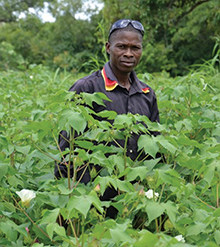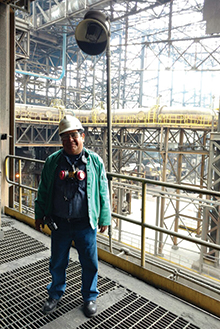Double-Edged Sword
Finance & Development, December 2016, Vol. 53, No. 4
A more integrated global economy is affecting workers around the world

Slideshow: Globalization's Faces ![]()
Globalization shapes lives in countless ways. Driven by the mobility of people, capital, and ideas and aided by information technology, it brings opportunities for a better life to some, dislocation and hardship to others.
In this article F&D profiles six people on five continents who—for better or worse—have been affected by globalization.
Some are struggling. In the United States, one worker lost his manufacturing job because of foreign competition but managed to land on his feet thanks to government-funded retraining. In Switzerland, new technology and the strength of the Swiss franc are forcing traditional Swiss watchmakers to confront a dual threat—competition from trendy smartwatches and cheaper labor from neighboring France. In Burkina Faso, a farmer’s ability to thrive in the global cotton market has fueled the economy’s growth. Both his livelihood and Burkina Faso’s economy, though, are threatened by competition from richer countries that can afford to subsidize production.
Others are benefiting—but the picture is often nuanced. In the Philippines, relatively low labor costs and a well-educated English-speaking workforce allow outsourcing companies to thrive. Peru has benefited from a dramatic rise in international copper prices, thanks mainly to China’s insatiable demand for metal. And in France, previously disenfranchised workers in a rough Paris suburb are now able to find jobs because of the introduction of ride-hailing applications like Uber.
Second act
John Powers


John Powers rises before dawn and travels 60 miles to his workplace in Pittsburgh, Pennsylvania. Some days, he doesn’t get back until 9 p.m. after a hard day installing electric gates. At age 60, the Air Force veteran earns $12 an hour—and considers himself lucky just to have a job.
“I’ve had five places shut down on me or have forced reductions in my working career,’’ Powers said on a recent Sunday, relaxing in an armchair by the fireplace in his tidy clapboard home in Rices Landing, a small town in southwestern Pennsylvania.
For generations, residents of Rices Landing and other communities along the banks of the Monongahela River were assured of well-paying work in coal mines and steel mills and the network of businesses that supported them, from equipment suppliers to power plants. That started to change in the 1980s, when the steel industry was decimated by overseas competition.
Today, the unemployment rate in Greene County, where Powers lives, is 7.1 percent, one of the highest among counties in Pennsylvania, which has a statewide rate of 5.7 percent.
Among the recent casualties of overseas competition was the zinc smelting plant in Monaca, Pennsylvania, where Powers worked for 18 years repairing machinery. The foundry, which recovered zinc from electric arc furnace dust in steel mills, fell victim to imports of inexpensive galvanized steel, which is coated with zinc.
The owner, Horsehead Corporation, started to lay off more than 500 employees, Powers among them, in 2013 and closed the plant the following year. To compete with imports, Horsehead built a lower-cost smelter in North Carolina and moved production of zinc oxide to a factory in Canada.
“It scared the daylights out of me,’’ Powers recalled. “What was I going to do? I wasn’t 25 anymore.’’
A counselor at the Pennsylvania Department of Labor persuaded him to take advantage of a federal program to help workers displaced by foreign competition. Despite his misgivings about accepting government money for tuition, he enrolled in Pittsburgh Technical College to be retrained as an electrician.
It was difficult going back to school. He took courses in speech, writing, and mathematics along with electronics and physics. “I struggled,’’ he said. “There were things that just didn’t sink in. I had to go over them two or three times.’’ In the end, though, he decided he loved learning and earned his associate degree in 21 months, with a perfect attendance record and honors for high grades.
“When I graduated I was proud,” says Powers, an easygoing man with a toothy grin. “I did something I never thought I would do.”
Powers landed a job at a company that installs fences, where he had earlier worked as an apprentice. His hourly wage is half what he earned at Horsehead.
Many of his former buddies weren’t as fortunate, he says. Some have lost their homes. One, who teased him for going back to school, now makes $10 an hour as a laborer at a dairy farm.
“There’s just not a lot of money out there,’’ Powers said. “If you make $15 an hour around here, you’re doing real well. That used to be a starting salary at the steel mills.’’
He takes pleasure in his job, but the hard physical labor and long commute are taking a toll on Powers, who recently had surgery to replace an arthritic shoulder. In the past few months, he has applied unsuccessfully for more than 20 jobs closer to home, including one as head of maintenance at a municipal sewage-treatment plant.
Family ties keep him from looking farther afield. His father, an 84-year-old retired steelworker, still lives in nearby Beaver County, where Powers grew up. And Powers is engaged to be married, to Alisa Hatchett—a program supervisor at the state labor department who encouraged him to go to school.
All things considered, Powers says he’s fortunate. “Some people grumble,’’ he said. “I tell them, ‘The system did what it was supposed to do. It got you to school. Nobody’s going to guarantee you anything anymore. All they can do is help you.’ And they did.”
Reporting: Chris Wellisz
Photography: Martha Rial
Turbulent times
Lionel Parmentier


The watch industry has afforded Lionel Parmentier and his wife a comfortable lifestyle for the past 40 years. They live a stone’s throw from Switzerland’s renowned ski resorts, world-heritage wine regions, and the calm waters of Lake Geneva.
Almost a metaphor for the cozy economic cocoon in which Switzerland’s citizens are nestled, the watchmaker’s retail and repair shop, M. Parmentier, has meant four steady and reasonably prosperous decades for him and his family.
But that is not the case for the watch industry on which he depends, nor for his son, who followed in his father’s footsteps but is now out of work with, he says, little prospect of finding a suitable job.
Between 1995 and 2012, Swiss watchmakers rode a wave of growth, created by the seemingly insatiable demand for luxury goods from prospering emerging markets, particularly China. But demand from China has fallen markedly since 2012, and with it prosperity in the industry. Watchmakers were dealt another blow in January 2015, when the Swiss National Bank allowed the Swiss franc to soar in value by 15 to 20 percent. That significantly raised the price of Swiss watches abroad—a terrible setback for an industry that exports 95 percent of its production.

The Federation of the Swiss Watch Industry reports that exports of wristwatches have dropped 5.6 percent since 2011. Even more dramatically, exports fell 12.4 percent between the first half of 2015 and the first half of 2016. That has resulted in layoffs at major players such as Cartier, Vacheron Constantin, and Piaget. The Swatch Group (with brands such as Omega and Tissot) reported a 54 percent decline in operating profits for the first half of 2016.
But if the famous watch industry is suffering, the rest of the economy seems to be doing fine. Its GDP per capita of $60,500 is 8 percent higher than that of the United States (on a purchasing-power-parity basis). Other exports—notably of chemicals and pharmaceuticals—are growing, and the overall economy, stimulated in part by government consumption, is doing well. Wages are high and unemployment is low. Foreigners may not be buying Swiss watches, but there are still a lot of local customers coming to M. Parmentier.
But Lionel’s son, Raphael, lost his job during a recent round of layoffs at Compagnie Financière Richemont, whose brands include Cartier and Piaget. He had worked as a project manager in its dial manufacturing division for 10 years.
“The announcement came as a shock. We had just moved into a new building,” Raphael says.
Like many industry analysts, he is critical of the watchmakers’ strategic focus on the Chinese market. “I think to any outsider, it feels obvious that this is a dangerous way to do business,” he says. “They are very exposed to changes in the Chinese economy.”
Initially, Raphael, the father of two young children, felt confident he would pick up another job in the industry. But he soon discovered the entire profession was in trouble.
“The word I will use for finding a job in the industry at the moment is ‘impossible.’ The companies don’t hire many people anymore.”
Raphael blames cross-border commuters from France, who, he said, are happy to work for less pay. “In the carparks for these companies, all you see are French license plates. For the Swiss, it’s difficult to compete.”
Switzerland’s unemployment insurance system allows the younger Parmentier to claim about 80 percent of his salary for up to 18 months of job search. He has switched his career goals, setting his sights on Switzerland’s burgeoning space industry, where he believes his project management experience and technical skills will be a natural fit.
His father, though, is not about to give up on the industry that has been his livelihood for 40 years, even though the luxury market is threatened by smartwatches—which combine timekeeping with computer functions just as smartphones blend telephones and computers. The traditional wristwatch will endure, he says. A smartwatch “isn’t a watch; it is merely a screen. It’s not something you can pass down to the next generation.”
Reporting: Celeste Gorrell Anstiss
Photography: Anastasia Vishnevskaya
White gold
Kohoun Yorossi


Cotton, Burkina Faso’s second largest export after gold, provides 4 million growers with a living. One of them is Kohoun Yorossi, a farmer from the village of Kamandéna in the country’s west-central region.
Known locally as “white gold,” cotton accounts for nearly 40 percent of Burkina Faso’s GDP and, until 2009, represented close to 60 percent of its export earnings. Cotton farmers are shareholders in the country’s three cotton companies—SOFITEX, Faso Coton, and SOCOMA.
Under a blazing sun, Yorossi gives instructions to the driver of his tractor, who is applying pesticide to a field attacked by parasites. In his village in a region known as the country’s breadbasket for its agricultural potential, this 30-year-old has been farming 30 hectares—half of them planted in cotton—since 2002.
He earns, in an average year, more than $7,500.
“With what I earn, I was able to buy a fully equipped tractor three years ago. I was also able to improve my standard of living. Before, we lived in old houses, but now the family is comfortable and everything is fine,” he says.
Between 2008 and 2010, however, Yorossi’s production fell by nearly half. Discouraged by low prices, some farmers—including Yorossi—abandoned cotton in favor of grain crops, while others cut back on the number of hectares planted.
Another devastating blow was the widespread switch to genetically modified, or Bt, cotton, following the arrival of the U.S. firm Monsanto. Bt cottonseeds were sown throughout the country in 2009, after several years of experimentation. This new breed of cotton—which requires significantly less pesticide—held great promise for farmers, who had long struggled to keep their crops free of parasites.
But farmers found that the genetically modified crops produced cotton with shorter fibers and a duller color, making it less attractive than conventional cotton on the international market and damaging the reputation of Burkinabè cotton, long renowned for its quality.
“With GMOs, we had been promised the moon, but we ended up worse off,” he explains.
There are also broader issues. Burkina Faso’s increased dependence on cotton has exposed the economy to external shocks, such as drought, flooding, and declines in the international price of cotton, as the country has experienced in recent years.
To support the cotton industry, the government has kept the price of seeds, fertilizer, and other inputs at $25 a bag and raised the price it will pay for a kilogram of seed cotton from 34 cents to 40 cents. That pleases Yorossi. This increase will cost the Burkinabè government about $53 million for a planted area of 800,000 hectares.
With this support from the government, a timely supply of the high-quality inputs he needs, and prompt payment for his cotton earnings, Yorossi hopes to do his part to help the country meet its production target.
But he has a bone to pick with his global competitors. Burkina Faso’s cotton exports face stiff competition from large-scale producers, particularly those supported by subsidies in countries such as the United States. Like many of his fellow farmers, he opposes such subsidies, which he feels destabilize local production.
There has been progress. In World Trade Organization negotiations, Africa’s “Cotton 4”—Benin, Burkina Faso, Chad, and Mali—have found support for an agreement that would curb export subsidies in rich countries and open up the market for cotton exports from the poorest countries. Countries such as Australia, Canada, Japan, Switzerland, and the United States and in the European Union have committed $295 million in development assistance to Africa’s cotton sector—but as of mid-2016, less than half had been disbursed.
“We are not asking them to stop helping their growers. We just ask that they honor their commitments and allow African cotton to become a means of development for millions of poor people,” Yorossi says.
Reporting and photography: Tiego Tiemtoré
Good call
Rain Tan


When Rain Tan followed his colleagues in the hospitality industry into the fledgling call center industry in 2001, he did not imagine that it would grow into what it is today, the second largest source of foreign exchange for the Philippines and one of its largest employers.
When he joined the call center eTelecare, Tan, who was part of the team that managed hotel reservations at the old Mandarin Oriental Manila, was motivated only by the thought of being part of something new and exciting.
“I just thought at that time that it was an interesting setup,” says Tan. “I have also always been attracted to working at odd hours. I guess the industry then did not know where to recruit people. The hospitality industry seemed the closest fit, because they needed people who could work evenings and had customer service skills and facility with the language.”
Tan, then 24, firmly believed he had nothing to lose and everything to gain. “I felt I could always bounce back if I made a mistake,” says Tan, a marketing management graduate of De La Salle University in Manila.
Instead, joining the business process outsourcing industry turned out to be one of the best professional decisions he’s made.
Tan continued climbing the corporate ladder, moving from agent to team leader and finally to vice president for human resources of Convergys Philippines, one of the pioneers of the business process outsourcing industry in the Philippines and the country’s largest private employer.
According to the latest government data, the industry is expected to earn $25 billion this year, from $3.2 billion in 2006. In 2016, it employs roughly 1.3 million Filipinos, compared with 240,000 in 2006. This growing industry—which involves performance of specific business processes, such as accounting, payroll, or telemarketing—accounts for close to 8 percent of the country’s GDP; in 2006 it was 2.6 percent.
This share is expected to increase further because the Philippines is well positioned in such key indicators as an experienced talent pool; cultural affinity with the United States, one of the biggest sources of outsourcing jobs; and the number of college graduates.
Given the growth prospects—still bright, government and industry officials say, despite newly elected President Rodrigo Duterte’s recent tirades against the United States—Tan says that business process outsourcing companies must prepare the industry for the next wave of growth.
From voice services, such as customer support and sales of products and services, the Philippines must move up the value chain to capture a greater market share of nonvoice and higher-value-added services, including analytics and financial services, from countries such as India.
It has always been tough to hire enough qualified people. Aside from having to work at night and endure calls from angry clients, English fluency and the ability to talk to customers are basic requirements.
In an industry where jumping from one center to another is becoming more the rule than the exception, Tan says he stresses to his employees that they are contributing significantly to the economy and providing a valuable service worldwide.
It is these realities that keep Tan in his post.
“Clients have always said the level of service that we provide is the best they can find,” Tan says. “We take care of people sincerely, and that is a brand we have as a people.” But it is time, he adds, for the outsourcing industry in the Philippines to expand into new business areas, especially those that pay a higher salary for workers.
“In this game, the first entrant usually gets the biggest slice of the pie. So the sooner we get to the higher-value-added and sophisticated jobs, the better for us and the better for the country,” Tan says.
Reporting: Tina Arceo-Dumlao
Photography: Courtesy of Convergys One
Taking a shine to copper
Walter Ascona


Walter Ascona is a mentor, both within and outside the copper foundry of Southern Peru Copper in Ilo, in the Moquegua region. He always encourages young people to speak up. “Don’t be afraid to ask questions, because there is always something to learn,” he says, recalling his own experience when he arrived in Ilo as a young man 41 years ago.
About to become a father, Ascona left the University of Tacna in his second year of mechanical engineering studies. He started working as a laborer, then rose quickly through the ranks. Today, at 63, he heads the foundry processes team.
He is highly respected inside the foundry and out. He served three terms as mayor of the Pacocha District while working afternoons and evenings in mining. For 15 years he was also a union leader at Southern and a member of the General Workers’ Union of Peru.
Southern, acquired by Grupo México in 2010, is one of the largest copper mining companies in the world, accounting for more than 60 percent of Peru’s national copper production. “Here, I learned about everything: camaraderie, friendship, how to ask, how to demand. I hope to continue working here, because it is an essential part of my life,” Ascona says. “Mining has provided me with a good living.”
The company has not benefited just Ascona and his colleagues, it has also boosted the development of infrastructure in both Ilo, site of the processing facilities, and nearby Toquepala, where the mine is located.
Like Chile, Peru enjoyed strong economic growth as a result of the rise in international copper prices and the upsurge in copper exports to China. The Peruvian securities market tripled in size between the end of 2008 and the end of 2010, and in 2012 Peru was the world’s third largest copper producer. But after the metals boom came the Asian collapse, and with it the metals crash, creating chaos in the global economy.
“In 2007, wages began to rise, and we workers—laborers and employees—had annual earnings of between 80,000 and 100,000 soles. We never imagined having so much money.” recalls Ascona. “There was a multiplier effect, as cab drivers, businesses, and everything else benefited. But in a crash, everything also falls.”
“We are part of the global economy,” he adds. “We went from less than a dollar per pound of copper to $4. We all gained from it, our purchasing power grew, we consumed freely; the company got involved in social work and invested in it, too. But the bonanza didn’t last, and now—with copper at just over $2 a pound—we have to be careful. The company is still making money, but not as much. Same for us.”
Globalization is necessary, especially for a country like Peru. But there are also risks, and Ascona knows this. Nevertheless, he believes that Peru’s leaders should commit to diversifying their economy so that the future of its people doesn’t depend so heavily on mining.
“The collapse of copper prices blew up in our faces, and we weren’t prepared; we need economic alternatives and strong political will,” he maintains.
Ascona also calls attention to another key issue: environmental protection. “I believe Peru should little by little promote investments that will not only provide economic growth but also generate sustainable development, with more jobs, more secure incomes, and fewer harmful effects on people and the environment,” he explains.
The father of three adult children and the eldest of six siblings, Ascona is greeted affectionately on the streets of Ilo. His family looks forward to the day he can retire, but he isn’t thinking about that now. He keeps his white hard hat clean and ready for work, on whichever shift he’s assigned. He is working—not just for Southern, but to keep Peru moving forward.
Reporting: Alberto Ñiquen Guerra and Karla Chaman
Photography: Alberto Ñiquen Guerra
Escape route
Farah Abdellah


It’s only a five-minute walk from the “Périphérique,” a ring road that separates Paris from the millions of people living around the French capital. Yet it is a totally different world. Here in Aubervilliers, a town of 80,000 people that was once part of Europe’s largest industrial zone, the unemployment rate is well over 20 percent. Many residents are of foreign descent and are struggling to make ends meet.
Over the past 15 years, the city of Aubervilliers and the French government have invested millions of euros in urban regeneration. Former factories have been transformed into fancy new office buildings and shopping centers. In September 2016, the U.S. transportation company Uber opened a service center there, for one reason: most of the drivers live nearby, in Seine-Saint-Denis.
Though under government scrutiny and harshly criticized by traditional taxi drivers, Uber became an instant success in Paris. In 2015, in Seine-Saint-Denis alone, 2,700 drivers joined the California start-up, almost 80 percent of the total in France. About 40 percent of them were previously unemployed.
The success of the Uber center was almost immediate: every day a long line forms at the entrance. Some visitors come to apply as drivers, others to get accounting advice or other services provided by Uber-selected partners. Still others are here to take advantage of the free courses Uber offers.
One such visitor is Farah Abdellah, a Moroccan immigrant in his 50s. For 23 years he had been making a good living as a director of production in the textile printing industry. About two years ago, his employer, Finishtex, went bankrupt, leaving Abdellah without a job. Uber now offers him a different path. “Becoming an independent driver is a great way to change my career. And this company has an international reputation, so I see only the benefits.”
To many French people, “ubérisation” is a dirty word. It stands for poorly paid jobs in a world where everyone is an independent contractor and no one is protected. Yet most people milling about this Uber service center have a positive view. “I want to start my own company, something I’ve always dreamed of,” says Abdellah. “I would really prefer to become an entrepreneur. I’ll continue looking for work in my field of expertise.”
After his first day as a driver, Abdellah weighs in. “It was different than I thought. It is actually quite a challenge to be sitting in the car for a whole day,” he says. “It may be a temporary solution, but at least I’m working again.”
More than elsewhere, being an Uber driver in Paris has a social aspect. “A lot of our drivers never came into the city before they joined us. Now they get out of their grim neighborhoods and speak to Parisians from all backgrounds. It gives them a different perspective and more self-confidence: they realize that it is possible to escape the suburbs,” says one of the center’s employees.
Uber may well be one of the largest job creators in Seine-Saint-Denis. Despite its promises, the government has not been able to solve the unemployment problem there. “Now this private company is doing the job the government should do,” explains Abdellah.
There’s another, more subtle, reason suburbanites like working for Uber. The area’s postal code, 93, symbolizes gritty housing, violence, and poverty. “A lot of the people you see here have been looking for work for a long time. When businesses see “93,” they simply throw our resumes in the trash, even if we’re perfectly qualified,” says Abdellah, with irritation. “But not Uber.”
Reporting and photography: Stefan de Vries
Opinions expressed in articles and other materials are those of the authors; they do not necessarily reflect IMF policy.


